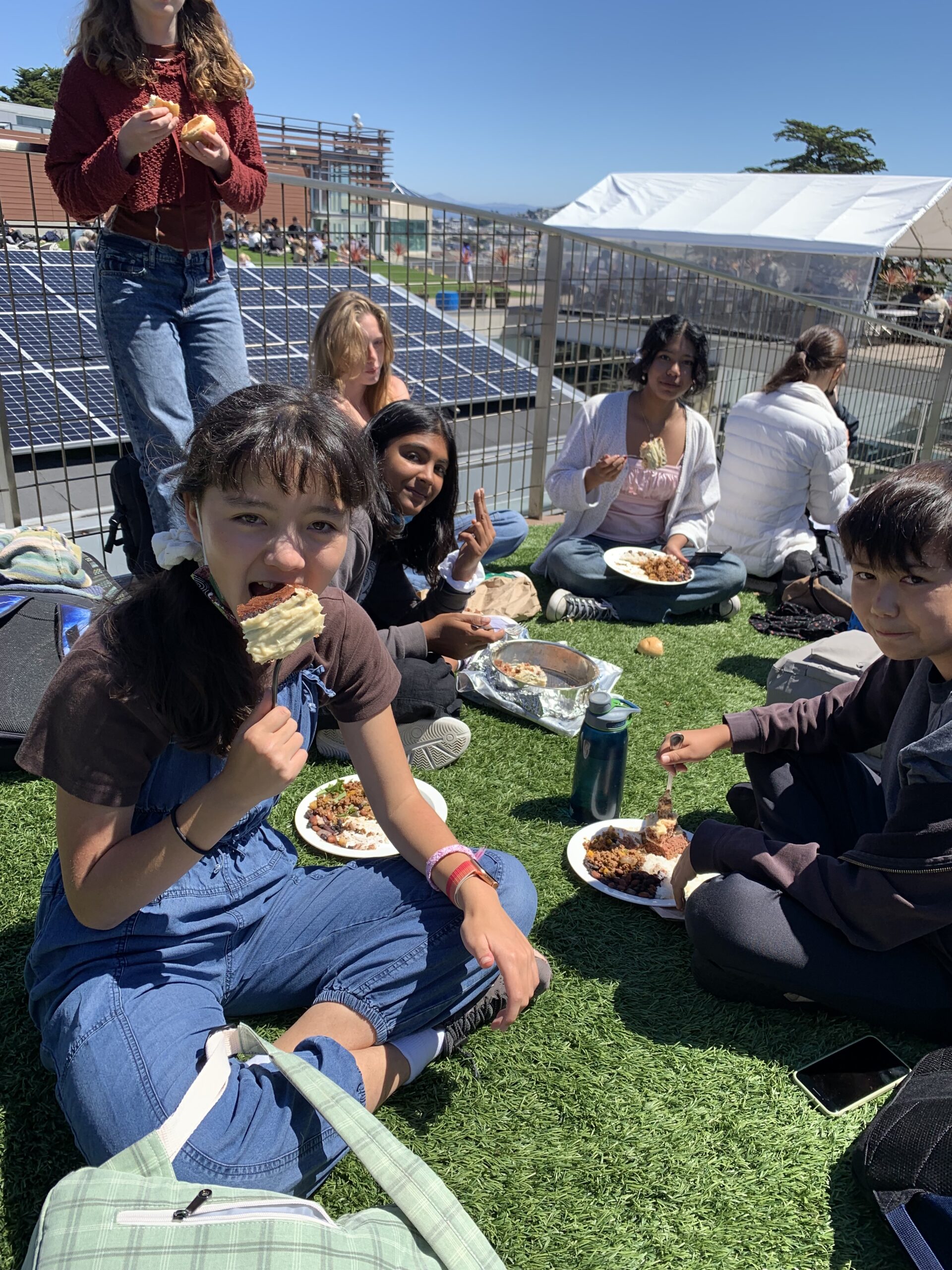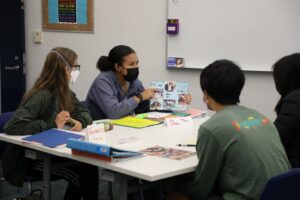Around the city, many food programs have persisted in providing good, nutritious meals to those who otherwise don’t have access to such food. However, recently programs have felt the strain of rising food prices, especially when it comes to maintaining a high standard of nutrition. At Lick-Wilmerding High School, where nutrition is heavily valued in the context of food, what does recognizing and reckoning with privilege look like?
Outside of the LWHS community, many efforts exist to expand access to nutritious food. On 9th and Market, under a seafoam green awning, resides the San Francisco Friends Meeting House (Quakers). Prior to the pandemic, the meeting house would open their doors on Sundays, allowing community members free access to high-quality groceries. After returning to a mostly pre-pandemic state, the pantry has transformed into an equally vibrant program known as Friday Food Share. Every Friday evening, members and volunteers head around the block, handing out sandwiches and other necessities such as hand sanitizer and socks to people who likely could not afford them.
Five minutes away at Glide Memorial Church, a line stretches almost entirely down the block as people stand awaiting a meal. Some people stand with their dogs; some are locked in conversation with a neighbor and others stand stoically. Everyone waits their turn. Somewhere overhead, upbeat music blares out of a speaker. At the front of the line, people are handed boxes of hot, nutritious breakfast. While it is currently 7:30 am, Glide serves meals three times a day, to anyone who might need them.
Both of these programs, along with countless others scattered around the Bay Area, provide aid to people who often cannot afford food otherwise. “We’re seeing a lot of new faces. Almost every day. New people to San Francisco and new people to Glide. People who need help,” said George Gundry, the Director of the Daily Free Meals Program at Glide. As Gundry described, the need for food in the Bay Area has intensified as of late.
The San Francisco Chronicle reports that in the Bay Area, 870,000 people are food insecure. Simply put, this means that 870,000 people cannot reliably predict if and where they will get three meals a day. The more complicated answer is that food insecurity also relates to the “availability of nutritionally adequate and safe foods,” as put by the U.S. Department of Agriculture (USDA).
Both Glide and the Quaker Meeting House aim to combat food insecurity by not solely providing meals but providing delicious and nutritious meals. However, the simple fact is that nutritious food is expensive, especially in the current state of food inflation.
To accommodate rising food prices and the subsequent rise in need that is seen by the Quaker Meeting House, they have had to increase their budget significantly. Monique Flambures, who has been participating in food programs at the Meeting House since 2016, said, “In the past it’s been like maybe $1,000 a year. Last year [2022] it was $3000 and this year [2023] it’s $5000.”
The rising cost of food that has radically impacted the Meeting House’s budget has also been felt nationwide. The USDA reported that in March 2023, all food prices were 8.5 percent higher than they were a year prior, in March 2022.
Glide, too, has dealt with challenges in terms of their budget. Commenting on what the increase in food prices has meant for them, Gundry said, “Well it makes us be a little bit more strategic, a little bit smarter. You know, we’re very fortunate that people are good to Glide.”
Ultimately, both programs aim to provide delicious, nutritious food. Gundry explained how at Glide, there is a nutritionist who comes in to check on the quality of their food. “Well, everybody deserves healthy, nutritious food meals. And you know, not only that, we want our meals to be popular to eat as well. We want our clients to enjoy our food and not just come here because there’s no other option, but come here because our food is good,” he said.
Often, people who seek meal assistance cannot access healthy, nutritious food in other ways. Much of this is due to what is called food redlining. As defined by Cornell Law School, redlining is “a discriminatory practice that consists of the systematic denial of services such as mortgages, insurance loans and other financial services to residents of certain areas, based on their race or ethnicity.” Food redlining is something similar.
LWHS History teacher Rene Villicaña described the manifestation of this term. “If you go to neighborhoods that are socio-economically in poverty, there’s limited access to fresh produce or basic goods, but there’s a proliferation of liquor stores. Whereas in middle and upper middle class neighborhoods, there’s fresh produce and organic, biodynamic markets on every corner,” he said.
Food redlining is primarily about who has access to nutritional foods, but also impacts who has access to information about food and nutrition. Villicaña said, “it’s not just a question of, ‘can you afford better quality products?’ It also includes levels of what formal education people received, in what culture people were raised, because food practices are just one thing determined by what was modeled when you were younger.”
This reality is especially important to confront at LWHS, a community that puts extra care into ensuring students have access to extremely good food daily. All LWHS lunches are designed to delight; offerings range from the classic pesto pasta to yellow coconut curry to Mayan chicken. In addition to being delicious, it’s safe to say these lunches are nutritious. Meals at LWHS are crafted intentionally to meet nutrition requirements. Most meals include starch, a vegetable, protein and a salad.
Kathleen Fazio, Director of Food Services, discussed the process by which LWHS lunches are crafted. She said, “I think it’s our interest in not only the quality of the ingredients but the quality of the outcome. Today is chicken mole, and we’ve been working on that sauce for three days.”
While food prices have increased of late, there has been minimal effect of that on the nutrition levels of LWHS lunches. Essentially, quality is almost always valued over price at LWHS. “We probably could do things cheaper. But we are fortunate to have the budget to do it right,” Fazio said.
So what does the responsibility of confronting the realities of food injustice look like at LWHS? This question is central in a school with such a high standard of nutrition and a location within a city plagued by food inequality. For Lori Agbabian ’24, the responsibility starts at a more personal level. “LWHS Students definitely love to be nourished but it is important to be aware that there are other people who might not have as great lunches as we have,” she said.
LWHS 11th and 12th Grade Dean Kindra Briggs spoke about the responsibility to be aware of community efforts aimed at targeting food injustice. “I think our responsibility is to understand the work that other people are doing and start to participate and listen and learn. People are out there changing the world — what do they want from us? Let’s engage in conversation and figure out what that means in terms of our partnership,” she said.
So next time you dive into a plate of LWHS lunch, take a moment to reflect: what does it mean to have access to nutritious food?







рабочий промокод 1хбет бонус http://lipetskregionsport.ru/news/pages/1hbet_promokod_na_6500_pri_registracii.html